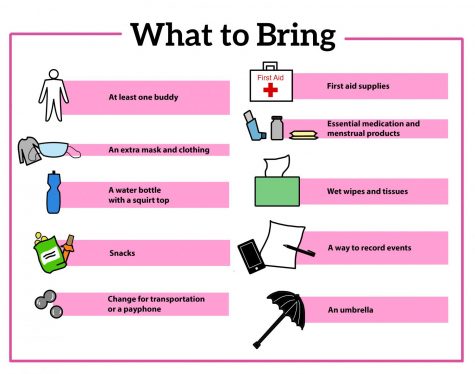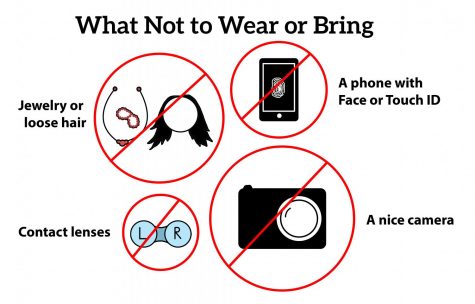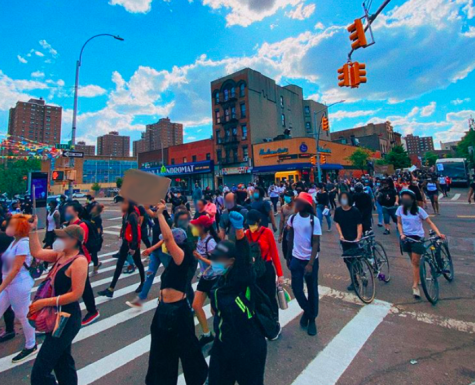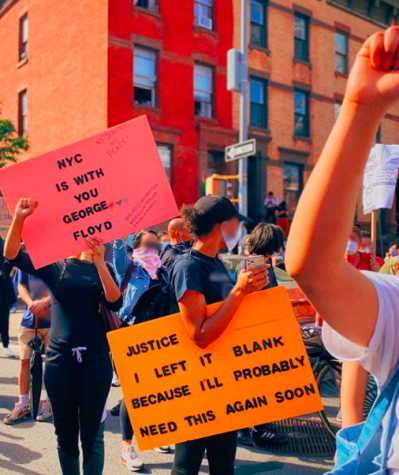Protest Guide: Dress for Success (and Survival)
June 5, 2020
With mass protests occurring in all 50 states and internationally, the social unrest caused by the murder of George Floyd is only growing. If you’re looking to exercise your First Amendment rights by taking to the streets in protest, staying informed is your best weapon and your best defense. The advice compiled below is based on the experience of activists around the globe.
The role you play
- There is no single right way to protest. Whether you’re chanting on the frontlines or helping distribute water and supplies in the back, whether you’re sitting quietly with your hands up or putting the police on the defensive, you are contributing to the movement.
- If you’re not part of the persecuted group, try to follow the lead of protesters who are — let them lead chants and help amplify their voices.
- If you’re white or white-passing, you can use your privilege for good by being a shield for protesters more likely to face retaliation or violence.
- Don’t try to be a martyr. There are too many other people who will have that choice made for them.
- The advice outlined in this article can help you and others avoid danger, but it will not completely eliminate risk — nor should it. A protest is all about taking a risk, engaging in an act of shared vulnerability to make your voices heard. If it was perfectly safe, it would be a parade.
What to wear

- Dress in loose, comfortable clothing with no logos. Same for your shoes — you want to be able to run, and you don’t want to be identified later by your outfit. Chemical weapons will irritate any exposed skin, so cover up what you can.
- A mask or respirator that covers the lower half of your face is a must. Not only does it help protect you from chemical weapons and being identified, but it also keeps you and everyone around you safe from the coronavirus.
- Sunglasses or other eye coverings can further help you stay anonymous. Upgrade to tight-fitting ski or safety goggles to protect your eyes from projectiles and chemical weapons.
- Cover up any visible tattoos or other markings that could be used to identify you later.
- If you expect to be out for a while, bring a hat to shield you from the sun — it can also help hide distinctive hair. A biking or construction helmet might also save you from serious injury.
- If you are white, ignoring the advice above and dressing as respectable as possible can be an effective deterrent to police escalation. Keep in mind, though, that you will be more vulnerable if they decide to attack regardless.
What to bring

- Bring at least one buddy. Watch each others’ backs and stay in contact; help each other out if you’re attacked with chemical weaponry; don’t let them disappear. Plan your exit strategy and decide on a rendezvous point if things go south — keep in mind that public transport may be shut down.
- A backup mask and a second set of clothes are indispensable if you’re attacked with tear gas or pepper spray.
- Always bring a water bottle with a squirt top, to drink and to wash out your eyes and others’ in case of tear gas or pepper spray.
- Bring snacks to keep your energy up.
- Bring change for transportation fare or a payphone — your credit/debit card could be used to track you.
- Given that police forces often escalate and attack protesters, whether peaceful or not, you should pack some limited first aid supplies for this eventuality. Gauze/dressings and a wrap are sufficient for the average person, but if you want to become a medic there are resources for that as well.
- In case you are detained or otherwise unable to return home immediately, pack what essential medication you can, like insulin or an inhaler.
- Menstrual pads, for those who need them, are better options than tampons because they are easier to change — bring a few extra in case you are detained, or use a diva cup.
- Wet wipes and tissues can help clear your face and skin of dirt and chemicals.
- If you are a witness to police brutality, you will want some way to record events. Video on your phone is one option, but a watch, pen and paper will also suffice.
- It’s helpful to pack a small umbrella in case of rain, but if necessary, it can also block pepper spray.
- Heat-resistant gloves are necessary if you have to pick up tear gas canisters and hurl them away from yourself and others.
What not to wear or bring

- Not only can jewelry and loose hair identify you, but you can also be grabbed and pulled by them.
- Contact lenses are less likely than glasses to be lost or damaged, but they can trap chemicals against your eye — as can eye makeup. Lotions or oils can do the same for your skin, so they are best avoided to minimize the impact of chemical weapons.
- A nice camera is a target for both protesters and police who do not wish to be documented, and is best left at home.
- If you bring your phone, turn off Face and Touch ID — they can be used to unlock your phone without a warrant.
The smartphone question
- Consider if you need to bring your smartphone. On one hand, it’s indispensable to record evidence, keep in contact with others and generally avoid danger — on the other hand, it can and will be used to track and monitor you and others. This is not a hypothetical, and you may be identified and face retaliation from the government as a result. Consider turning on airplane mode and wrapping your phone in aluminum foil to block its signal when not in use, or better yet, purchasing a burner phone to discard before you return home.
What to post, what not to post
- Never RSVP for a protest, and be careful with language that places you or others at the action. Activists in the United States and elsewhere have faced retaliation for their participation in protests, and your social media posts can be used as evidence against you and others.
- Images or video that show protesters’ faces are the most dangerous, but you can also be identified by your clothes and shoes — show as little detail as possible, and scrub the metadata from your photos using online tools.
- An exception to this is when a protester is being arrested — ask them to yell out their name and date of birth. This information can be passed on to bail services and other volunteer legal organizations to help them get out of jail.
- If you record an instance of police brutality, sharing it on social media can help hold them accountable — ideally with the permission of the victim(s) and a content warning.
What to do when police are violent

- Police can and will detain, beat, imprison or kill you, and they may attack without reason or warning. As such, direct conflict is to be avoided. Running may make you a target or cause a stampede; back away slowly until you can flee safely. Help others get away.
- If no media outlets are on site, documentation by you and other protesters is the only way to hold police accountable. Film what you can — identify yourself, the time, date and location; try to get their faces and badge numbers. Eyewitness testimony (with permission) is also valuable. Have a buddy watch your back to avoid tunnel vision.
How to respond to tear gas and pepper spray
- If you’re wearing eye protection and a mask, you should have a short period of time to get away from tear gas. Move upwind and uphill. Stay calm and take slow, shallow breaths.
- Help others who are having trouble seeing to move away. Don’t scream or run.
- If tear gas or pepper spray gets in someone’s eyes, have them remove any contact lenses, hold their eyelids open and use your water bottle to wash each eye from the inside corner out. Be ready to do this for your buddy, and consider practicing with them.
- Immediately discard and replace a contaminated mask. You should try to do this for your clothing as well, if possible.
- Blow your nose, rinse and spit, cough, sneeze, try not to swallow. Don’t rub it into affected areas, wash them instead.
- Evidence for other remedies — milk, liquid antacid, vinegar, citrus, onions, etc. — is anecdotal at best, and none of these should be in contact with your eye. The only proven treatments are water and saline.
- Seek out a volunteer medic for further treatment if you need one, or become one yourself.
- At home, take the coldest shower you can and wash until the burning stops — hot water opens your pores and makes things worse. Wash contaminated clothing separately with cold water and harsh detergent.
- For protesters who prefer a proactive approach, activists in Hong Kong and elsewhere have pioneered new techniques to neutralize tear gas using jugs of water, traffic cones and even leaf blowers. Of course, you can always just throw, kick or even swat gas canisters right back at police.
What to do if you’re arrested

- Ask “Am I free to go?” and “Am I being detained?” to confirm if you are being arrested.
- Know your rights, even though there is no guarantee police will respect them. If they are violated, record the event and you may be able to hold them accountable.
- Tell them: “I invoke my right to remain silent and my right to legal counsel.” That general sentiment is all you have to say, and it’s all you should say until a lawyer is with you. Many legal offices offer pro bono services for protesters, though some reject clients that they determine were insufficiently “peaceful.” Find a firm that will represent you before you go to the protest, and memorize their number or write it on your body. Stay calm — don’t let them terrorize or gaslight you into signing or consenting to anything, including unlocking your phone for them, even if they threaten to seize it.
What is the role of violence in a protest?

- Destructive protest has been an American tradition since the Boston Tea Party, but keep in mind that it is most effective when directed at symbolic targets, like government offices, police precincts, certain corporations and other entities that have contributed to the systemic inequality and injustice that we denounce. Chaos and wanton violence can be more damaging that helpful, and some of those who may encourage it are suspect.
- There are dozens of reports from all across the country of police officers going undercover to smash windows and set fires, or incite protesters to do the same. Be wary of these tactics, and learn to identify and avoid intentional provocation. This is an ideological clash as much as it is a physical one; police will attempt to control the narrative to both justify and obscure their own violence as well as to demonize protesters. Resist these efforts at every turn.
- If you are attacked, you have every right to defend yourself and try to drive off your attacker — but anyone who does so will likely face significant retaliation and lasting consequences.
- Violent action may be controversial, but it is worth remembering what actually constitutes violence — an attempt to injure or kill others. There is a world of difference between merely defacing or damaging structures and shooting a journalist in the eye. As has been said elsewhere, windows and merchandise can be replaced, but no one can undo the harm police brutality has done to Black Americans.
Alternatives to protest and other ways to help
- Not everyone is able to go to mass protest, and that’s okay. For example, if you are immunocompromised or have respiratory problems, chemical weapons and the coronavirus pose a serious threat — and for sole caregivers or undocumented immigrants, being arrested is far more dangerous than it is for others.
Note that marching in the streets is far from your only avenue to express your outrage. Donating to bail or mutual aid funds, signing petitions and other community activism are all excellent ways to contribute to the cause — even just amplifying the voices of other activists can help to bring change.











